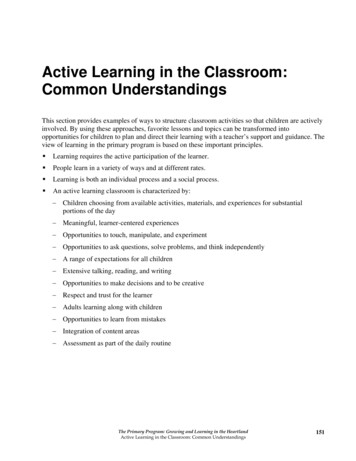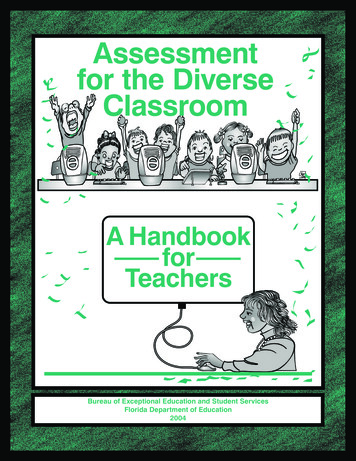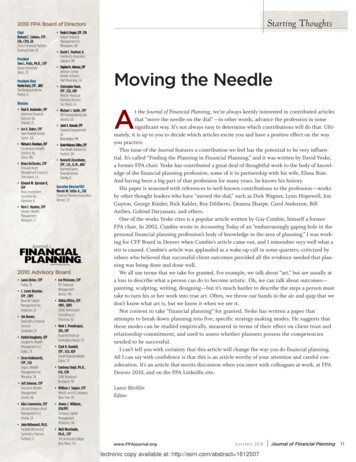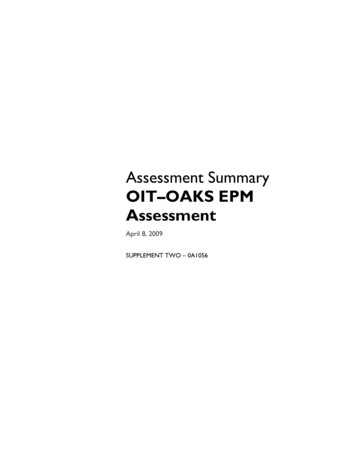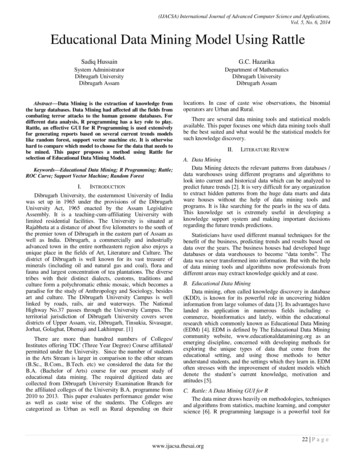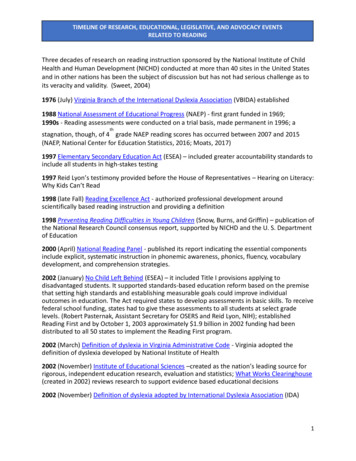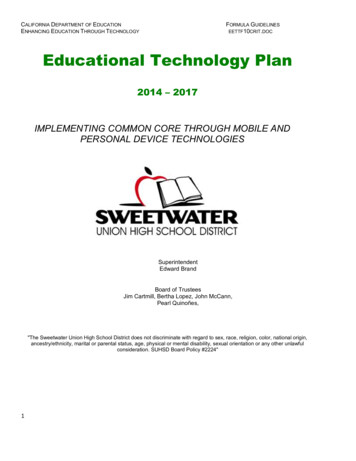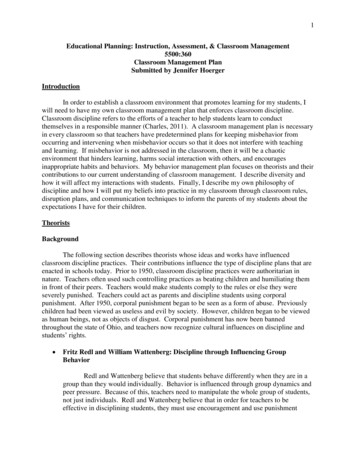
Transcription
1Educational Planning: Instruction, Assessment, & Classroom Management5500:360Classroom Management PlanSubmitted by Jennifer HoergerIntroductionIn order to establish a classroom environment that promotes learning for my students, Iwill need to have my own classroom management plan that enforces classroom discipline.Classroom discipline refers to the efforts of a teacher to help students learn to conductthemselves in a responsible manner (Charles, 2011). A classroom management plan is necessaryin every classroom so that teachers have predetermined plans for keeping misbehavior fromoccurring and intervening when misbehavior occurs so that it does not interfere with teachingand learning. If misbehavior is not addressed in the classroom, then it will be a chaoticenvironment that hinders learning, harms social interaction with others, and encouragesinappropriate habits and behaviors. My behavior management plan focuses on theorists and theircontributions to our current understanding of classroom management. I describe diversity andhow it will affect my interactions with students. Finally, I describe my own philosophy ofdiscipline and how I will put my beliefs into practice in my classroom through classroom rules,disruption plans, and communication techniques to inform the parents of my students about theexpectations I have for their children.TheoristsBackgroundThe following section describes theorists whose ideas and works have influencedclassroom discipline practices. Their contributions influence the type of discipline plans that areenacted in schools today. Prior to 1950, classroom discipline practices were authoritarian innature. Teachers often used such controlling practices as beating children and humiliating themin front of their peers. Teachers would make students comply to the rules or else they wereseverely punished. Teachers could act as parents and discipline students using corporalpunishment. After 1950, corporal punishment began to be seen as a form of abuse. Previouslychildren had been viewed as useless and evil by society. However, children began to be viewedas human beings, not as objects of disgust. Corporal punishment has now been bannedthroughout the state of Ohio, and teachers now recognize cultural influences on discipline andstudents’ rights. Fritz Redl and William Wattenberg: Discipline through Influencing GroupBehaviorRedl and Wattenberg believe that students behave differently when they are in agroup than they would individually. Behavior is influenced through group dynamics andpeer pressure. Because of this, teachers need to manipulate the whole group of students,not just individuals. Redl and Wattenberg believe that in order for teachers to beeffective in disciplining students, they must use encouragement and use punishment
2sparingly. Any punishment that is used should be pre-planned and mildly unpleasant.Students should know the consequences of inappropriate behaviors and quietly adhere tothe outcomes of their actions (Charles, 2011).The most useful part of Redl and Wattenberg’s theory is that group dynamics dohave an impact on students. Teachers need to assess group dynamics and peer pressureand design appropriate behavior plans to deal with inappropriate behaviors. On the otherhand, this theory addresses the behaviors of the entire group, but not individual behavior.Students still need to be held responsible for their own behavior. The teacher cannotcontrol the entire class through manipulating peer behavior. Individual students will needto be disciplined for their misbehavior as well. B. F. Skinner: Discipline through Shaping Desired BehaviorTheorist B. F. Skinner believed that behavioral choices are determined by theenvironmental conditions in which we live. Humans respond to reinforcements thatsatisfy their basic needs. Thus, teachers should use external stimuli, such as rewards orverbal reinforcement to encourage desired behaviors. Skinner did not believe in the useof punishment because it makes students avoid punishment, not the behavior. Skinnerbelieved that punishment would encourage students to be sly in order to avoid theconsequences for their misbehavior (Charles, 2011).The most useful part of Skinner’s theory is that it is simple to use and results areimmediate. Many students will feel successful when they obtain reinforcements for theirbehavior. This will encourage them to behave in order to gain rewards. The least usefulpart of Skinner’s theory is that the definition of reinforcements is generalized. Manyreinforcements will not encourage students to behave. Also, this way of managingbehavior seems like bribery. The theory does not encourage students to govern theirbehavior in a responsible way, but rather to behave in order to receive extrinsic rewards. Lawrence Kohlberg: Stages of Moral DevelopmentKohlberg argued that people progress through stages of moral reasoning, witheach stage requiring more complex reasoning. Individuals in the preconventionalmorality level behave primarily based on consequences of behavior. Individuals in theconventional morality level accept society’s laws and expectations, which help governbehavior. In the postconventional morality level, behavioral decisions are more abstract,and may be based on principles like human rights and personal beliefs of right andwrong. Kohlberg believes that individuals will learn self-discipline as they move throughthe moral stages and develop better reasoning skills that will aid them in actingresponsibly. At first, students will behave in order to avoid discipline. As they grow andmature, they will recognize the importance of rules and adhere to them. Eventually,students will develop higher reasoning that will help them to make moral decisions(Ormrod, 2009).The most useful part of Kohlberg’s theory is that the stages of moral development
3are consistent with Piaget’s stages of cognitive development. The early stages ofKohlberg’s theory are based on the belief that young children are egocentric. As studentsprogress through the moral stages, they move from egocentric thinking to logicalthinking. Eventually some students achieve higher-level moral reasoning requiringanalytical thinking. This moral development of students is consistent with Piaget’sstages of cognitive development (Ormrod, 2009). The least useful part of Kohlberg’stheory is that it does not describe how teachers should discipline students. The theorydescribes how students are expected to behave based on their stages of moral reasoning.However, individualized methods of encouraging positive behavior are not described orstated in the theory. Jacob Kounin: Improving Discipline through Lesson ManagementJacob Kounin believes that classroom management is influenced by teachercontrol. Students will pay attention in class and behave if the teacher has engaginglessons with smooth transitions between interesting activities. Exciting lessons willengage students and keep them from misbehaving. Kounin also believes that“withitness” plays a role in classroom management. The teacher’s ability to be aware ofeverything that is going on in the classroom and to act in control will encourage studentsto behave. Kounin believes that classroom management and discipline go hand-in-hand.When teachers have smooth transitions, overlapping activities, and exciting presentationsduring lessons, students will behave. When students do misbehave, the teacher shouldquickly address the problem, and then continue teaching so that the lesson keeps flowingand other students are not given time to misbehave (Charles, 2011). The most useful parts of Kounin’s theory are the concepts of “withitness” andsmooth transitions between activities in lessons. Knowing what is going on in theclassroom at all times will help teachers to identify and deal with misbehaviors quicklybefore they escalate into more severe problems. Having smooth transitions betweenlessons will also help students to stay focused on learning and will leave little time formisbehavior to occur. The least useful part of Kounin’s theory is that it does not addresswhat the teacher should do when a student does misbehave. Misbehavior in classroomswill occur, despite engaging lessons and smooth transitions. Kounin’s theoryaddresses how to avoid discipline problems, but not how to solve serious difficulties thatmay arise.Haim Ginott: Discipline through Congruent CommunicationGinott believes that students’ behavior is greatly influenced by communicationbetween the teacher and students. The way in which a teacher communicates withstudents will influence the way that they react under specific circumstances. Ginottbelieves that teachers should not use evaluative praise with students, but should talkabout how the behavior influences and affects others so that students will realize thattheir actions affect those around them. Ginott believes that punishment should not beused because it can cause the student to be hostile and angry, leading to moremisbehavior and little resolution for negative behaviors. Rather, teachers shouldpositively communicate with students and avoid characterizing them (Charles, 2011).
4The most useful part of Ginott’s theory is that the communication between teacherand students will encourage students to learn to talk and interact with others in anacceptable and appropriate way that avoids characterization of individuals. This isimportant, since characterization can hurt others’ self-esteem. Students will learn thatwhat they say has a powerful influence on others. On the other hand, this method ofdisciplining through communication is not as effective because sometimes teachers needto deal with inappropriate behaviors right away regardless of whether or not students’feelings will be hurt in the process. At times, teachers will need to hastily quellmisbehavior to keep all the students safe, even if it injures the self-esteem of a student. Rudolf Dreikurs: Discipline through Democratic TeachingTheorist Rudolf Dreikurs believed that the way that students behave is based onsocial status. Students will behave in order to get attention, gain power and control,exercise revenge, or display their feelings of inadequacy. Dreikurs believed thatinappropriate behaviors can be avoided by helping students find ways to satisfy theirneeds. Discipline can be established in the classroom through democratic teaching thatencourages students to be responsible for their actions and make decisions. Rather thanpunishing students for mistakes, teachers should focus on the students’ strengths and howthey can grow and learn from their mistakes. Penalties for misbehavior should beappropriate for the misbehavior, not more or less severe (Charles, 2011).The most useful part of Dreikurs’ theory is the idea of disciplining studentsthrough democratic teaching. This method of discipline will encourage students to learnself-discipline, which will help them be more responsible individuals capable of learningfrom mistakes. The least useful part of Dreikurs’ theory is that disciplining studentsthrough democratic teaching may be too time-consuming. It might take teachers too longto find the underlying cause for misbehaviors so that students’ needs can be satisfied topromote appropriate behaviors. Lee and Marlene Canter: Discipline through Assertive TacticsLee and Marlene Canter believe that students choose to conduct themselvesproperly or improperly. Regardless of how students choose to behave, they are expectedto adhere to the rules so that students can learn and the teacher can teach withoutinterruptions. Teachers can use positive reinforcements such as verbal praise toencourage good behavior in the classroom. Lee and Marlene Canter believe that assertivediscipline should be used in the classroom to encourage students to refrain from badbehavior. Teachers should intervene and deal with misbehavior in a calm, consistentmanner that uses consequences for students who break the rules (Charles, 2011).The most useful aspect of the Canters’ theory is that clear expectations forbehaviors are given and modeled for students in the classroom rules. Students have aclear understanding of why there are rules and what the consequences will be if theymisbehave. Therefore, students have no excuse for misbehavior if they know how they
5are expected to behave. The least useful aspect of this theory is that it fails to deal withthe underlying causes of students’ behavior. Sometimes students might misbehavebecause their basic needs are not being met. The Canters’ theory fails to address howteachers should deal with misbehavior that is a direct result of the need for survival,safety, and belonging. William Glasser: Discipline Guided by Choice TheoryWilliam Glasser believes that students’ behavior is controlled by student choice.Teachers cannot control students’ behavior, but they can influence them to do thingsleading to better behavior. Teachers can encourage good behavior by providing activitiesand experiences that will satisfy students’ basic needs of security, belonging, power, fun,and freedom and that will motivate them to keep working in order to fulfill those needs.Teachers can accomplish this through meaningful lessons. Glasser believes innoncoercive discipline, in which the teacher helps students to make choices that lead tosuccess and fulfillment. Encouraging students to make responsible choices will helpthem to develop inner discipline (Charles, 2011).The most useful aspect of Glasser’s choice theory is his belief that teachers shouldprovide meaningful experiences and lessons that will motivate students to learn. It isimportant for teachers to use this lead teaching, which will establish a learningenvironment that is conducive to student learning and encourage students to learn asmuch as possible. The least useful aspect of Glasser’s choice theory is that it can be timeconsuming to help each individual student satisfy his needs all the time. Also, byencouraging student
theory is that it does not describe how teachers should discipline students. The theory describes how students are expected to behave based on their stages of moral reasoning. However, individualized methods of encouraging positive behavior are not described or stated in the theory. Jacob Kounin: Improving Discipline through Lesson Management

